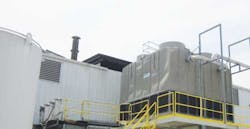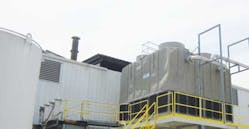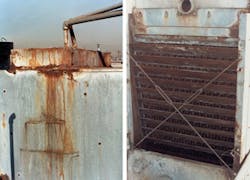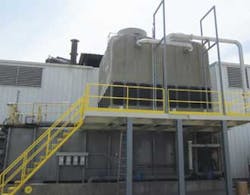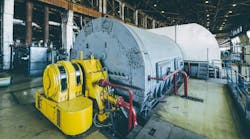By Ed Sullivan
Manufacturers of aluminum extrusions are highly dependent on the availability of high-quality billet, which can sometimes be difficult to procure either in cut lengths or logs. Without billet, extrusions do not get run and on-time deliveries do not occur, particularly with custom products. This situation can put customers at risk.
For that reason, Sierra Aluminum Company, a full-service manufacturer of standard and custom aluminum extrusions, has its own billet casting foundry that features the acclaimed Wagstaff Billet Casting System.
Sierra's billet casting operation supplies its extrusion manufacturing facilities in Riverside and Fontana, Calif., with premier-quality aluminum billet "logs" that are then extruded into standard or custom shapes and lengths, and put through finishing processes such as machining, thermal treating, anodizing and painting.
The billet logs that Sierra manufactures are 21 feet long, and seven, eight or nine inches in diameter. Utilizing the Wagstaff system, billets are created from pouring molten aluminum through tooling of specific dimensional characteristics. As the process continues, logs are formed to length and diameter desired by the manufacturer.
"At the tooling, these logs have a shallow molten metal core and a solid exterior," said Shayne Seever, vice president of administration at Sierra. "They are cooled in a direct chill process by water that is sprayed on the solid metal skin as it continuously exits the Wagstaff molding system."
Seever explained that the direct chill process is a continuous loop that includes no heat exchangers. After it leaves the spray system, water is re-cooled solely by means of a cooling tower. The only coolant involved is normal tap water with the addition of a small amount of corrosion inhibitor plus a minor pH adjustment.
"The cooling tower is a key component, and it is subjected to water that is used to remove 18- to 24-million BTUs of heat from the molten billet logs each hour," Seever said. "For that reason we have typically worn out all of our previous cooling towers -- the traditional metal-clad type -- in five years or less. After that, we were faced with either repairing or replacing them."
Going in a new direction
For most applications, either of those alternatives -- repairing or replacing cooling towers -- is a costly situation. Either way, production is interrupted, and the out-of-pocket expense can be surprisingly exorbitant.
"We were frankly tired of that replacement cycle," Seever said. "So, we looked for an alternative to the metal-clad cooling tower." Stainless steel models were available but at a prohibitive cost so Sierra considered another technology manufactured by Delta Cooling Towers (Roxbury Township, N.J.) that featured a high-density polyethylene (HDPE) plastic fill. "We liked that approach particularly because the fill had the capability to withstand high temperatures," he explained. "It is rated to 160˚F, which gives us a nice safety margin."
Seever explained that most of the cooling towers Sierra has owned or considered have had fill temperature ratings of about 120˚F to 140˚F. Because his company's molding process sometimes heated coolant water to over 140˚F, the fill in those towers would melt.
"As soon as you melt the cooling tower fill, you lose cooling efficiency, and you have to replace the fill or the entire tower," he said. "Otherwise, you really start to generate a lot of steam and cause other problems inside the tower itself."
Seever added that another advantage of the HDPE tower is that it is impervious to corrosion. "If the tower is galvanized metal, it doesn't seem to matter what type of corrosion inhibitor you put on it; eventually the corrosion will break through it and start eating the steel," he said.
The Delta model that Sierra purchased was a 738-Ton TM Model. TM Series induced draft, counter flow models are available in single unit capacities from 250 to 2,000 cooling tons, and may be clustered to provide much greater capacities.
Beyond cooling capacity
Other major benefits that attract many industrial, commercial and institutional users to the advanced, engineered HDPE cooling tower design include significantly reduced maintenance and energy costs.
HDPE is not only impervious to corrosive water treatment chemicals but also to corrosive elements that are often present in the air, whether harsh chemical vapors emitted from nearby industrial plants or natural corrosives such as salt air.
Seever recalled visiting another company, a paper-processing mill, that had an exceptionally corrosive environment.
"Because of the paper processing, they get fugitive particles in their cooling system water, and those particles provide all kinds of nutrients that promote the growth of bacteria," he explained. "They were slugging their cooling tower with full-strength sodium hypochlorite (chlorine), but that treatment was not damaging their Delta tower. So, from that perspective, with the steam and the heat that we generate compared to the strong bleach that they were using, we figured we wouldn't have anything to worry about in terms of the service life of our new tower." When Seever asked the plant manager if he would buy the same tower again, he said he would. "That's all I needed to hear."
The Delta towers are available with direct drive fans, which can greatly reduce maintenance and electricity costs. With direct drive motors, there are no belts or gear reducers, internal gearbox or bearings to take care of, and it is unnecessary to "tune up" the balance of the fans, as is often required with shaft- or belt-driven motors. Normal maintenance includes lubricating the motor bearings once a year as part of normal PM program. Direct-drive motors can be PM'd while they are running, so there is negligible maintenance downtime.
The efficiency of direct drive fan motors coupled with variable-speed drives can also reduce energy costs considerably. The tower Sierra purchased includes a direct drive motor plus a frequency drive that the company installed so that a thermostat can be used to maintain a consistent water temperature in the process. This results in large reductions in kilowatt usage since the full motor horsepower is rarely needed.
"My anticipation is that, with this drive configuration, we will save tens of thousands of dollars each year on energy costs, compared with what we were spending with our previous tower," Seever said.
About the Author: Ed Sullivan is a Hermosa Beach, Calif.-based writer. He has researched and written about high technologies, healthcare, finance, and real estate for over 25 years.
